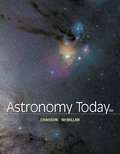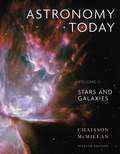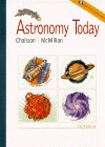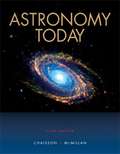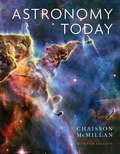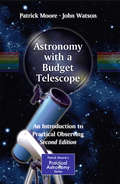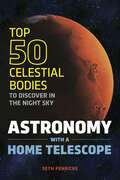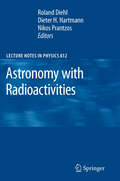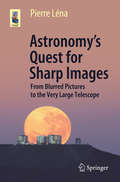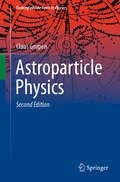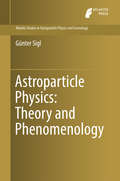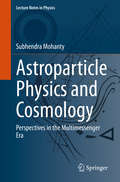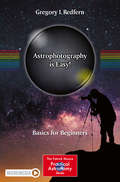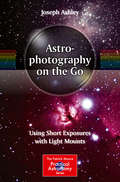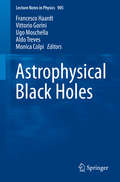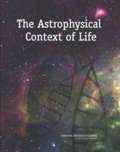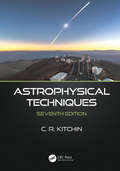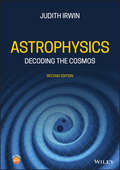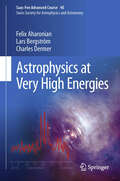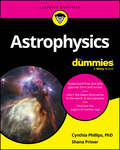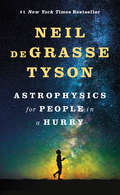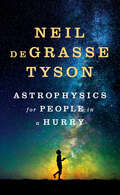- Table View
- List View
Astronomy Today
by Eric Chaisson Steve McMillanWith Astronomy Today, Eighth Edition, trusted authors Eric Chaisson and Steve McMillan communicate their excitement about astronomy and awaken you to the universe around you. The text emphasizes critical thinking and visualization, and it focuses on the process of scientific discovery, making “how we know what we know” an integral part of the text. The revised edition has been thoroughly updated with the latest astronomical discoveries and theories, and it has been streamlined to keep you focused on the essentials and to develop an understanding of the “big picture.” <P><P> Alternate Versions <P><P> Astronomy Today, Volume 1: The Solar System, Seventh Edition—Focuses primarily on planetary coverage for a 1-term course. Includes Chapters 1-16, 28. <P><P>Astronomy Today, Volume 2: Stars and Galaxies, Seventh Edition—Focuses primarily on stars and stellar evolution for a 1-term course. Includes Chapters 1-5 and 16-28.
Astronomy Today: Stars and Galaxies (7th Edition)
by Eric Chaisson Steve McmillanIn this book, the authors Eric Chaisson and Steve McMillan communicate their excitement about astronomy and awaken you to the universe around you. The text emphasizes critical thinking and visualization, and it focuses on the process of scientific discovery, making "how we know what we know" an integral part of the text. The revised edition has been thoroughly updated with the latest astronomical discoveries and theories.
Astronomy Today (3rd edition)
by Eric Chaisson Steve McmillanThis textbook is suitable for a college undergraduate survey for non-majors.
Astronomy Today (Fifth Edition)
by Eric Chaisson Steve McMillanFor one- or two-semester introductory courses in astronomy. Chaisson/McMillan is a trusted text that offers the most complete and innovative learning package available for introductory astronomy. The goal of the Fifth Edition is to focus on the process of discovery and to better convey how science is done. Particular attention was given to clearly and concisely presenting scientific terms to the non-science student. Volume 1 includes Chapters 1-16, plus chapter 28. Volume 2 includes Chapters 1-5 plus 16-28.
Astronomy Today, Volume 1: The Solar System (7th edition)
by Eric Chaisson Steve McmillanWith Astronomy Today, Seventh Edition, trusted authors Eric Chaisson and Steve McMillan communicate their excitement about astronomy and awaken you to the universe around you. The text emphasizes critical thinking and visualization, and it focuses on the process of scientific discovery, making "how we know what we know" an integral part of the text. The revised edition has been thoroughly updated with the latest astronomical discoveries and theories, and it has been streamlined to keep you focused on the essentials and to develop an understanding of the "big picture."
Astronomy with a Budget Telescope: An Introduction to Practical Observing (The Patrick Moore Practical Astronomy Series)
by Patrick Moore John WatsonAstronomy with a Budget Telescope, 2nd Edition is a complete introduction to buying and using a low-cost amateur astronomical telescope. It provides essential hints and tips about what to look for when buying on a budget - the best are now excellent value, but they all lack an astronomer's advice about setting them up and using them. Astronomy with a Budget Telescope was first published in 2003, since then technology has moved on substantially. The main factors are first the availability of fairly inexpensive computer-controlled "go-to" telescopes which after setting up can automatically locate any celestial objects with reasonable accuracy. Second, digital cameras have now almost completely displaced "wet" film cameras, and some of them are particularly well-suited to astronomical use. Third, prices are down and quality is up! This new edition is revised and extended to include using a low-cost "go-to" telescope - there are various pitfalls to be avoided - and how this class of instrument can make amateur astronomy more accessible to those with limited time at their disposal. It also discusses the new breed of mid-range digital cameras that include powerful on-board processing and image enhancement software that used to be available only to people with advanced astronomical CCD cameras. Finally, there are detailed reviews and test reports on some of the budget telescopes that are available on Main Street and by mail order.
Astronomy with a Home Telescope: The Top 50 Celestial Bodies to Discover in the Night Sky
by Seth PenrickeSee What's Out There To experience the greatest show on Earth, all you have to do is look up. Whether you're stargazing from a bustling city or a small-town backyard, Astronomy with a Home Telescope helps you deepen your appreciation of the diverse, dazzling constellations—with either a home telescope or a pair of binoculars. Ideal for budding astronomers to astronomy buffs, Astronomy with a Home Telescope provides the origin and history behind the celestial bodies and how they came to be in space. Featuring full-color photos, easy-to-follow chapters, and helpful resources, this introductory guide will deepen every astronomy enthusiast's know-how of the night sky. Get set for stargazing, with: Informative profiles of the 50 most common astronomy objects, from the Moon to Mars to Venus, plus fun astronomy pop culture references A double-page spread featuring a clear schedule of solar and lunar eclipses Budget-friendly tips for viewing with the naked eye or binoculars Expert tips for cleaning and maintaining low- or high-powered telescopes Expand your horizons. Astronomy with a Home Telescope is the ideal companion for exploring the cosmos.
Astronomy with Radioactivities (Lecture Notes in Physics #812)
by Nikos Prantzos Roland Diehl Dieter H. HartmannThis book introduces the reader to the field of nuclear astrophysics, i.e. the acquisition and reading of measurements on unstable isotopes in different parts of the universe. The authors explain the role of radioactivities in astrophysics, discuss specific sources of cosmic isotopes and in which special regions they can be observed. More specifically, the authors address stars of different types, stellar explosions which terminate stellar evolutions, and other explosions triggered by mass transfers and instabilities in binary stars. They also address nuclear reactions and transport processes in interstellar space, in the contexts of cosmic rays and of chemical evolution. A special chapter is dedicated to the solar system which even provides material samples. The book also contains a description of key tools which astrophysicists employ in those particular studies and a glossary of key terms in astronomy with radioactivities.
Astronomy’s Quest for Sharp Images: From Blurred Pictures to the Very Large Telescope (Astronomers' Universe)
by Pierre LénaSince the 1960s, astrophysical discoveries have blossomed, due to the emergence of powerful and new observational tools. Among them, a fantastic improvement of the sharpness of astronomical images, obtained with ground based optical telescopes, has been the result of two revolutions: adaptive optics and optical interferometry. Written for a general audience, interwoven with fascinating details about the evolution of vision and optics, this book tells a personal story of these revolutions in observational astronomy, born two centuries ago and blossoming in the past fifty years. With the construction of the Very Large Telescope in Chile, Europe played a leading role where young scientists, joining creative astronomers and engineers, have developed a superb creativity. Today, incredibly sharp images of exoplanetary systems and black hole environments are obtained and reveal new questions about Earth-like objects or fundamental physics. The author has been one of the actors of this adventure. His first-hand testimony is opening the future to new horizons.
Astroparticle Physics (Undergraduate Texts in Physics)
by Claus GrupenDescribes the branch of astronomy in which processes in the universe are investigated with experimental methods employed in particle-physics experiments. After a historical introduction the basics of elementary particles, Explains particle interactions and the relevant detection techniques, while modern aspects of astroparticle physics are described in a chapter on cosmology. Provides an orientation in the field of astroparticle physics that many beginners might seek and appreciate because the underlying physics fundamentals are presented with little mathematics, and the results are illustrated by many diagrams. Readers have a chance to enter this field of astronomy with a book that closes the gap between expert and popular level.
Astroparticle Physics: Theory and Phenomenology (Atlantis Studies in Astroparticle Physics and Cosmology #1)
by Günter SiglThis books aims at giving an overview over theoretical and phenomenological aspects of particle astrophysics and particle cosmology. To be of interest for both students and researchers in neighboring fields of physics, it keeps a balance between well established foundations that will not significantly change in the future and a more in-depth treatment of selected subfields in which significant new developments have been taking place recently. These include high energy particle astrophysics, such as cosmic high energy neutrinos, the interplay between detection techniques of dark matter in the laboratory and in high energy cosmic radiation, axion-like particles, and relics of the early Universe such as primordial magnetic fields and gravitational waves. It also contains exercises and thus will be suitable for both introductory and advanced courses in astroparticle physics.
Astroparticle Physics and Cosmology: Perspectives in the Multimessenger Era (Lecture Notes in Physics #975)
by Subhendra MohantyCosmology and astroparticle physics have seen an avalanche of discoveries in the past decade (IceCube - high energy neutrinos, LIGO - gravitational waves, Fermi- gamma-ray telescope, Xenon-1T - dark matter detection, PLANCK- cosmic microwave radiation, EHT picture of black hole, SDSS -galaxy surveys), all of which require a multidisciplinary background for analyzing the phenomena. The arena for testing particle physics models is in the multimessenger astronomical observations and at the same time cosmology now requires a particle physics basis for explaining many phenomena. This book discusses the theoretical tools of particle physics and general relativity which are essential for understanding and correlating diverse astronomical observations.
Astrophotography for the Amateur
by Michael A. CovingtonFirst published in 1999, this much expanded and updated edition of the best-selling handbook Astrophotography for the Amateur provides a complete guide to taking pictures of stars, galaxies, the Moon, the Sun, comets, meteors and eclipses, using equipment and materials readily available to the hobbyist. In this new edition, the book has been completely revised and now includes new chapters on computer image processing and CCD imaging; expanded advice on choosing cameras and telescopes; completely updated information about the films; a much larger bibliography; and hundreds of new photographs (in colour, and black and white) demonstrating the latest equipment and techniques. Astrophotography for the Amateur has become the standard handbook for all amateur astronomers. This expanded and updated edition provides an ideal introduction for beginners and a complete handbook for advanced amateurs. It will also appeal to photography enthusiasts who can discover how to take spectacular images with only modest equipment.
Astrophotography is Easy!: Basics for Beginners (The Patrick Moore Practical Astronomy Series)
by Gregory I. RedfernThere are many books covering different facets of astrophotography, but few of them contain all the necessary steps for beginners in one accessible place. Astrophotography is Easy! fills that void, serving as a guide to anybody interested in the subject but starting totally from scratch. Assuming no prior experience, the author runs through the basics for how to take astrophotos using just a camera—including cell phones and tablets—as well as a telescope and more sophisticated equipment.The book includes proven techniques, checklists, safety guidelines, troubleshooting tips, and more. Each chapter builds upon the last, allowing readers to master basic techniques before moving on to more challenging material. Also included is a comprehensive list of additional books and resources on a variety of topics so readers can continue expanding their skills. Astrophotography Is Easy! doesn’t simply teach you the basic skills for becoming an astrophotographer: it provides you with the foundations you will need for a lifelong pursuit.
Astrophotography on the Go: Using Short Exposures with Light Mounts (The Patrick Moore Practical Astronomy Series)
by Joseph AshleyNo longer are heavy, sturdy, expensive mounts and tripods required to photograph deep space. With today's advances in technology, all that is required is an entry-DSLR and an entry level GoTo telescope. Here is all of the information needed to start photographing the night sky without buying expensive tracking mounts. By using multiple short exposures and combining them with mostly 'freeware' computer programs, the effect of image rotation can be minimized to a point where it is undetectable in normal astrophotography, even for a deep-sky object such as a galaxy or nebula. All the processes, techniques, and equipment needed to use inexpensive, lightweight altazimuth and equatorial mounts and very short exposures photography to image deep space objects are explained, step-by-step, in full detail, supported by clear, easy to understand graphics and photographs. Currently available lightweight mounts and tripods are identified and examined from an economic versus capability perspective to help users determine what camera, telescope, and mount is the best fit for them. A similar analysis is presented for entry-level telescopes and mounts sold as bundled packages by the telescope manufacturers. This book lifts the veil of mystery from the creation of deep space photographs and makes astrophotography affordable and accessible to most amateur astronomers.
Astrophysical Applications of Gravitational Lensing
by Evencio Mediavilla José A. Muñoz Francisco Garzón Terence J. MahoneyGravitational lenses offer the best, and sometimes the only, means of tackling key problems in many fields of astrophysics and cosmology. According to Einstein's theory, the curvature of light-rays increases with mass; gravitational lenses can be used to map the distribution of mass in a Universe in which virtually all matter is dark matter of an unknown nature. Gravitational lensing has significantly improved our knowledge of many astrophysical phenomena, such as exoplanets, galaxies, active galactic nuclei, quasars, clusters, large-scale structure and the Universe itself. All these topics are covered fully in this book, together with two tutorials on lens and microlensing modelling. The future of lensing in relation to large surveys and the anticipated discoveries of thousands more gravitational lenses is also discussed, making this volume an ideal guide for postgraduate students and practising researchers in the use of gravitational lenses as a tool in their investigations.
Astrophysical Black Holes (Lecture Notes in Physics #905)
by Ugo Moschella Vittorio Gorini Francesco Haardt Aldo Treves Monica ColpiBased on graduate school lectures in contemporary relativity and gravitational physics, this book gives a complete and unified picture of the present status of theoretical and observational properties of astrophysical black holes. The chapters are written by internationally recognized specialists. They cover general theoretical aspects of black hole astrophysics, the theory of accretion and ejection of gas and jets, stellar-sized black holes observed in the Milky Way, the formation and evolution of supermassive black holes in galactic centers and quasars as well as their influence on the dynamics in galactic nuclei. The final chapter addresses analytical relativity of black holes supporting theoretical understanding of the coalescence of black holes as well as being of great relevance in identifying gravitational wave signals. With its introductory chapters the book is aimed at advanced graduate and post-graduate students, but it will also be useful for specialists.
The Astrophysical Context of Life
by National Research Council of the National AcademiesIn 1997, the National Aeronautics and Space Administration (NASA) formed the National Astrobiology Institute to coordinate and fund research into the origins, distribution, and fate of life in the universe. A 2002 NRC study of that program, Life in the Universe: An Assessment of U.S. and International Programs in Astrobiology, raised a number of concerns about the Astrobiology program. In particular, it concluded that areas of astrophysics related to the astronomical environment in which life arose on earth were not well represented in the program. In response to that finding, the Space Studies Board requested the original study committee, the Committee on the Origins and Evolution of Life, to examine ways to augment and integrate astronomy and astrophysics into the Astrobiology program. This report presents the results of that study. It provides a review of the earlier report and related efforts, a detailed examination of the elements of the astrobiology program that would benefit from greater integration and augmentation of astronomy and astrophysics, and an assessment of ways to facilitate the integration of astronomy with other astrobiology disciplines.
Astrophysical Techniques
by C.R. KitchinLong used in undergraduate and introductory graduate courses, Astrophysical Techniques, Seventh Edition provides an accessible yet comprehensive account of the innovate instruments, detectors, and techniques employed in astronomy and astrophysics. Emphasizing the underlying unity of all astronomical observations, this popular textbook provides a coherent state-of-the-art account of the instruments and techniques used in current astronomy and astrophysics. Fully updated throughout, this seventh edition builds upon the sixth edition, covering improved techniques and cutting-edge methods in the field, as well as other exciting new developments in gravitational waves, dark matter and energy, the use of photonics, and astronomy education and outreach, in addition to further detailed discussions on the latest scientific instruments and individual detectors. The book is written in a very accessible manner, and most of the mathematics is accessible to those who have attended a mathematics course in their final years at school. Nevertheless, the treatment of the topics in general is at a sufficiently high level to be of use to those professionals seeking technical information in areas of astronomy with which they might not be completely familiar. Key Features: Details the instrumentation and theory of astronomical observations, including radio waves, gamma rays, cosmic rays, neutrinos, gravitational waves and dark matter and energy and more Presents the background theory and operating practice of state-of-the-art detectors and instruments Fully updated to contain the latest technology and research developments
Astrophysics: Decoding the Cosmos
by Judith Ann IrwinThe new edition of the popular textbook for undergraduate astronomers, covers the "how" of astrophysics Astrophysics: Decoding the Cosmos, Second Edition, describes how information about the physical nature of stars and other celestial bodies is obtained and analyzed to gain a better understanding of the universe. This acclaimed introductory textbook makes the complex principles and theories underlying astrophysics accessible to students with basic knowledge of first-year calculus-based physics and introductory astronomy. Reader-friendly chapters explore physical processes using relevant examples and clear explanations of how radiation and particles are analyzed. Such analysis leads to the density, temperature, mass, and energy of astronomical objects. In the time since the first publication of Astrophysics, the power of telescopes has increased considerably. Reflecting advancements in the field, this new edition includes carefully reviewed and updated material throughout, including recent GAIA satellite results, new information from subatomic particles, neutrinos, and cosmic rays, and brand-new case studies on Gamma-ray bursters, soft repeaters, fast radio bursts, exoplanets, and signals from exoplanetary atmospheres. Retaining its focus on electromagnetic radiation, the second edition now covers more of the ways that information about the universe is acquired, such as particles, gravitational radiation, and meteoritics. This textbook: Describes complex processes in a clear and accessible manner Provides relevant background information on the physics and examples of the theory in practice to place the subject into context Includes new figures, case studies, examples, further readings, end-of-chapter problems of varying difficulty levels, and open-ended "Just for Fun" problems Features a companion website containing information required to solve the designated web-based problems in the text and a range supplementary learning material Astrophysics: Decoding the Cosmos, Second Edition, is the ideal intermediate textbook for second- and third- year undergraduate students in Astrophysics courses, as well as a useful resource for advanced undergraduate and graduate students looking to refresh their knowledge in basic concepts.
Astrophysics at Very High Energies: Saas-Fee Advanced Course 40. Swiss Society for Astrophysics and Astronomy (Saas-Fee Advanced Course #40)
by Charles Dermer Felix Aharonian Lars Bergström Marc Türler Roland WalterWith the success of Cherenkov Astronomy and more recently with the launch of NASA's Fermi mission, very-high-energy astrophysics has undergone a revolution in the last years. This book provides three comprehensive and up-to-date reviews of the recent advances in gamma-ray astrophysics and of multi-messenger astronomy. Felix Aharonian and Charles Dermer address our current knowledge on the sources of GeV and TeV photons, gleaned from the precise measurements made by the new instrumentation. Lars Bergström presents the challenges and prospects of astro-particle physics with a particular emphasis on the detection of dark matter candidates. The topics covered by the 40th Saas-Fee Course present the capabilities of current instrumentation and the physics at play in sources of very-high-energy radiation to students and researchers alike. This book will encourage and prepare readers for using space and ground-based gamma-ray observatories, as well as neutrino and other multi-messenger detectors.
Astrophysics For Dummies
by Cynthia Phillips Shana PriwerDiscover the undiscovered with this jargon-free introduction to astrophysics Astronomy is the study of what you see in the sky. Physics is the study of how things work. Astrophysics is the study of how things in the sky work, from large objects to tiny particles. Astrophysics For Dummies breaks it all down for you, making this difficult but fascinating topic accessible to anyone. Tracking the topics covered in a typical undergraduate astrophysics class, this book will teach you the essential pieces to understanding our universe. Get ready to launch into outer space with this ever-changing branch of science. Discover the latest advances in the world of astrophysics Understand how and why galaxies form and evolve Find out the origins of cosmic rays Get a standalone primer on the science or supplement your astrophysics courseStudents in introductory astrophysics courses and would-be astronomy buffs who want to better understand the mechanics of the universe will love Astrophysics For Dummies.
Astrophysics for People in a Hurry
by Neil deGrasse TysonOver a year on the New York Times bestseller list and more than a million copies sold. The essential universe, from our most celebrated and beloved astrophysicist. What is the nature of space and time? How do we fit within the universe? How does the universe fit within us? There’s no better guide through these mind-expanding questions than acclaimed astrophysicist and best-selling author Neil deGrasse Tyson. But today, few of us have time to contemplate the cosmos. So Tyson brings the universe down to Earth succinctly and clearly, with sparkling wit, in tasty chapters consumable anytime and anywhere in your busy day. While you wait for your morning coffee to brew, for the bus, the train, or a plane to arrive, Astrophysics for People in a Hurry will reveal just what you need to be fluent and ready for the next cosmic headlines: from the Big Bang to black holes, from quarks to quantum mechanics, and from the search for planets to the search for life in the universe.
Astrophysics for People in a Hurry
by Neil DeGrasse Tyson<P>The essential universe, from our most celebrated and beloved astrophysicist. <P>What is the nature of space and time? How do we fit within the universe? How does the universe fit within us? There’s no better guide through these mind-expanding questions than acclaimed astrophysicist and best-selling author Neil deGrasse Tyson. But today, few of us have time to contemplate the cosmos. So Tyson brings the universe down to Earth succinctly and clearly, with sparkling wit, in tasty chapters consumable anytime and anywhere in your busy day. <P>While you wait for your morning coffee to brew, for the bus, the train, or a plane to arrive, Astrophysics for People in a Hurry will reveal just what you need to be fluent and ready for the next cosmic headlines: from the Big Bang to black holes, from quarks to quantum mechanics, and from the search for planets to the search for life in the universe. <P><b>A New York Times Bestseller</b>
Astrophysics for Physicists
by Arnab Rai ChoudhuriDesigned for teaching astrophysics to physics students at advanced undergraduate or beginning graduate level, this textbook also provides an overview of astrophysics for astrophysics graduate students, before they delve into more specialized volumes. Assuming background knowledge at the level of a physics major, the textbook develops astrophysics from the basics without requiring any previous study in astronomy or astrophysics. Physical concepts, mathematical derivations and observational data are combined in a balanced way to provide a unified treatment. Topics such as general relativity and plasma physics, which are not usually covered in physics courses but used extensively in astrophysics, are developed from first principles. While the emphasis is on developing the fundamentals thoroughly, recent important discoveries are highlighted at every stage.
